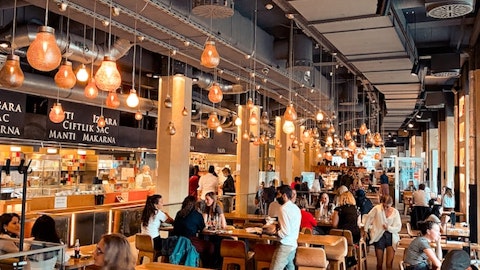Good Times Restaurants Inc. (NASDAQ:GTIM) Q1 2024 Earnings Call Transcript January 31, 2024
Good Times Restaurants Inc. isn’t one of the 30 most popular stocks among hedge funds at the end of the third quarter (see the details here).
Operator: Good afternoon, ladies and gentlemen. Welcome to the Good Times Restaurants Inc., Fiscal 2024 First Quarter Earnings Call. By now, everyone should have access to the company’s earnings release, which is available in the investor section of the company’s website. As a reminder, a part of today’s discussion will be – I’m sorry, will include forward-looking statements within the meaning of Federal Securities Law. These forward-looking statements are not guarantees of future performance, and therefore you should not put undue reliance on them. These statements involve known and unknown risks, which may cause the company’s actual results to differ materially from results expressed or implied by the forward-looking statements.
Such risks and uncertainties include, among other things, the market price of the company’s stock prevailing from time to time, the nature of other investment opportunities presented to the company, the disruption to our business from pandemics and other public health emergencies, the impact and duration of staffing constraints at our restaurants, the impact of supply chain constraints and inflation, the uncertain nature of current restaurant development plans and the ability to implement those plans and integrate new restaurants. Delays in developing and opening new restaurants because of weather, local permitting or other reasons, increased competition, cost increases or shortages in raw food products, other general economic and operating conditions, risks associated with our share repurchase program, risk associated with the acquisition of additional restaurants, the adequacy of cash flows and the cost and availability of capital or credit facility borrowings to provide liquidity, changes in federal, state or local laws and regulations affecting the operation of our restaurants, including minimum wage and tip credit regulations, and other matters discussed under the Risk Factors section of Good Times Annual Report on form 10-K for the fiscal year ended September 26, 2023, filed with the SEC and other filings with the SEC.
During today’s call, the company will discuss non-GAAP measures, which they believe can be useful in evaluating our performance. The presentation of this additional information should not be considered in isolation or as a substitute for results prepared in accordance with GAAP and reconciliation to comparable GAAP measures available in our earnings release. And now, I would like to turn the call over to Ryan. Please go ahead, sir.
Ryan Zink: Thank you, Christina, and thank you all for joining us on the call today. As mentioned, everyone should now have access to our first quarter earnings release. Joining me today is our recently appointed Senior Vice President of Finance and Accounting, Keri August. In a few minutes, she will review the quarter’s results. We engaged Keri in a consulting arrangement last August, and she immediately impressed me with her ability to quickly understand the company’s structure, identify opportunities within finance and accounting, and quickly build relationships with her now peers as part of our senior leadership team. I couldn’t be more pleased to have her join our team. Top line results this quarter were much the same as we reported last quarter with Good Times continuing to generate year-over-year sales growth and strong unit level margins.
While at Bad Daddy’s, we continue to work at turning around same store sales declines. Our results in December were encouraging, and even in the first week of the second quarter, we saw exceptional sales results at several stores, which posted single store weekly sales records. January sales have softened in part due to extreme cold and snow in both our Colorado market, which has experience with winter weather, but also in Tennessee and Alabama, where the city and county are not equipped to deal with the snow and ice on the roads. And interestingly in Huntsville, even the airport closed due to excess snow on the runways. In Colorado, the extreme cold contributed to softer sales at both brands with Denver staying below the zero degree mark for nearly three full days.
Nevertheless, Bad Daddy’s performance versus the Black Box index has improved significantly from November. And not only has the gap narrowed, but we have beat the USA comp sales index now the past two weeks in a row. In particular, our dinner daypart has recovered nicely with sales now nearly achieving prior year sales on a same store basis. We attribute this to the extra hour of operations and focus on last hour sales, delivering the same experience in the last half hour of dining as in any other hour of the day. On January 17th, we launched concept wide daily drink specials, along with the Last Call Happy Hour, where we have discounted apps during the last two hours of each business day. Additionally, our winter seasonal specials began on that same day.
Our seasonal specials are a key way in which we demonstrate the unique culinary capabilities of Bad Daddy’s and that extends to our beverage offerings now as well. We’re bringing chili back to the menu for the winter season, which has been the long requested burger topping that we eliminated during the pandemic, and it is featured on our Cowboy Crunch Burger and individually as a side. Bad Daddy’s bacon hummus and a Cherry Chocolate Shake round out the food offerings with Tequila and Rum based mule interpretations called the Mojo Mule and the Silver Blood & Ginger. Those getting rounded out with the Cranberry & Pear, Pretty-In-Pink mocktail that is an excellent fit for the season. Our next iteration of culinary innovation will create mass at both the high end and low end of price points for our burgers, providing options for those seeking value, and for those who are less price sensitive and are looking for insanely large burgers that Bad Daddy’s has become known for.
We took a blended menu price increase of approximately 1.1% in January and are currently sitting on about 5% year-over-year menu price in Colorado and 3% year-over-year in the rest of the country with our January price increase being limited to the Colorado and Atlanta markets. Colorado continues to be the highest cost market in which we operate driven by statutory and market based wage pressures, with our Atlanta market falling in between Colorado and the rest of the system in terms of wage pressure. Our Madison Restaurant, Huntsville weather notwithstanding continues to perform remarkably well as we discussed in a press release a couple of weeks ago. We have a highly capable very dedicated team in that restaurant and our Madison Restaurant was one of the very few restaurants in Huntsville that did not close during the extreme weather.
We’re working on a development pipeline and are looking at opportunities both in Birmingham and Charlotte. We’re currently negotiating to leases and have several other LOIs that are under negotiation. At Good Times we are focused on customer adoption of our loyalty platform GT Rewards. We continue to believe that digital engagement with our customers at Good Times is critical to continuing our sales momentum. By reducing friction at all points in the transaction, we can improve speed, accuracy and ultimately customer satisfaction. We’ve installed digital boards at the walk-up windows at our company-owned restaurants, eliminating all print merchandising across the company-owned system. We have yet to realize the full capability of the digital boards, which will enable day part merchandising strategies, weather enabled pricing and product decisions and other opportunities to adjust pricing promotion and general merchandising in near real time.

Six franchise restaurants still do not have digital walk up boards, two of which are co-branded with Taco John’s. Of those we have commitments to install digital walk up boards at three franchise restaurants, and the commitment of the last Colorado franchisee with a legacy drive through board to convert to digital this year. We’ve remodeled three of our Good Times restaurants, including murals by local artists, new awnings and new signage. We expect to complete one more remodeled this year, a more extensive one in the Denver Suburb of Lakewood. This is one of three Good Times that has never had a prior remodel and has an older kitchen layout that is less efficient. We expect this remodel to include the closure of the restaurant for three to four weeks.
We purchased just over 160,000 shares during the quarter at an average price of $2.70 per share. We believe that the share repurchase program, particularly at current trading prices for our stock generates a good return for shareholders. Good Times continues to generate reliable cash flow, and we have confidence in our turnaround strategy for Bad Daddy’s. Our stock is currently trading below book value per share and a low multiple of cash flow, and we believe that the true value of the business is greater than what the market’s currently valuing it. At the end of the quarter, we had approximately $1.3 million remaining under the – as authorized under the current repurchase program. I will now turn the call over to Keri to review our performance for the quarter.
Keri August : Thank you, Ryan, and thanks for your kind words earlier. I’m happy to be here today and happy to be part of the team. I’ll now review this quarter’s results. Total revenues decreased approximately 0.8% for the quarter to $33.1 million. Total restaurant sales for Bad Daddy’s Restaurants decreased $1.1 million to $24.1 million for the quarter. The sales decline was a combination of reduced sales associated with the closure of the Cherry Creek Restaurant in prior year, reduced customer traffic in several key markets, partially offset by an approximate 4.2% menu price increase, as well as sales from the Madison, Alabama restaurant, which opened during fourth quarter of 2023. Same store sales declined 6.2% for the quarter, with 39 Bad Daddy’s in the comp base at quarter end.
Cost of sales at Bad Daddy’s were 31.5% for the quarter, a 20 basis point decrease from last year’s quarter, with benefits from costs versus the prior year period across our basket. Though we have experienced lower purchase prices for food and paper goods recently, we expect ground beef and other food-based commodities to increase in the second half of fiscal 2024. Bad Daddy’s labor cost increased by 100 basis points compared to the prior year quarter to 35.8% for the quarter. This increase as a percentage of sales reflects higher wage rates and the deleveraging impact of lower sales on management costs. Occupancy costs at Bad Daddy’s increased 20 basis points to 7.1%. Bad Daddy’s other operating costs increased by 80 basis points compared to the prior year quarter to 14.8% for the quarter, primarily the result of increased repair and maintenance, technology and utility expenses offset by lower delivery commissions.
Overall restaurant level operating profit, a non-GAAP measure for Bad Daddy’s was approximately $2.6 million for the quarter or 10.7% of sales compared to $3.2 million or 12.7% last year. Total restaurant sales for company-owned Good Times restaurants increased approximately $0.8 million to $8.8 million for the first quarter compared to the prior year first quarter. The average menu price increase for the quarter was approximately 4.6% over the same prior year quarter. Same store sales increased 4.1% for the quarter with 25 Good Times restaurants in the comp base at quarter end. Food and Packaging costs for Good Times were 30.8% for the quarter, a decrease of 210 basis points compared to last year’s quarter, as we experienced lower purchase prices in our commodity basket compared to the prior year period.
As is the case with Bad Daddy’s, the longer term forecast indicates resumed pressure on beef and other food prices from current levels. Total labor costs for Good Times decreased 33.8%, a 110 basis point decrease from the 34.9% we ran during last year’s quarter. Due to the 4.6% menu price increase, as well as increased productivity partially offset by higher wage rates. Occupancy costs at Good Times were 8.9%, a decrease of 20 basis points from the prior year quarter. Good Times other operating costs were 13.0% for the quarter, an increase of 90 basis points, primarily due to increased delivery commissions, as well as increased repair and maintenance and utility expenses. Good Times Restaurant level operating profit increased by $0.3 million for the quarter to $1.2 million.
As a percent of sales, restaurant level operating profit increased by 240 basis points versus last year to 13.5%, due primarily to the improvement in food and packaging costs. Combined General & Administrative Expenses were $2.3 million during the quarter or 7% of total revenues, a 10 basis point decrease from last year. Our net loss to common shareholders for the quarter was $0.6 million or loss of $0.05 per share versus net loss of $0.1 million, $0.01 per share in the first quarter last year. Approximately $0.1 million of income tax expense was reported during the quarter. Adjusted EBITDA for the quarter was $0.3 million compared to $0.7 million for the first quarter of 2023. We finished the quarter with $3.5 million in cash and $1.3 million of long-term debt.
With that, I will turn the call back to Ryan.
Ryan Zink : Thank you, Keri. Christina, we can now open the call for questions.
Operator: Thank you. [Operator Instructions] Our first question comes from Sanjay Raghada [ph], who is a Personal Investor. Please go ahead, sir.
See also 15 Navies with the Most Submarines in the World and 40 Richest Countries in the World by Per Capita Net Worth.
Q&A Session
Follow Good Times Restaurants Inc. (NASDAQ:GTIM)
Follow Good Times Restaurants Inc. (NASDAQ:GTIM)
Unidentified Analyst: Hi, Ryan. So I wanted to talk about – I think you touched on the cash flow aspect of it. So I think fiscal year ‘23 operating cash flow was about $8 million. Is that kind of the projection for this year? How is it looking for this year?
Ryan Zink : Yeah, so I think in terms of adjusted EBITDA, last year was a little bit less than that. I’m going from the top of my head to say that full year was on the order of between $5 million and $6 million. I think for this year, obviously we have started off the year behind last year’s cash flow and adjusted EBITDA. I do expect for improvement in future quarters from what we’re — from what we produce this quarter. And so, I think my best projection for that, although we’re not offering any official guidance, is really that on the same order of last year is probably reasonable to expect for this year.
Unidentified Analyst : Okay. And for bad debt, are you still expecting the same stores sales increase in the second half of the fiscal year?
Ryan Zink: So I think on the last call that we had, I had said that – I wasn’t making any official projections, but that I had hoped that by the second half of the year that that might be possible. I think one of the things that we’ve noticed in the Black Box numbers, which is a benchmarking service that’s specific to the restaurant industry and also if you’re familiar with KNAPP-TRACK, is that there’s been some deterioration in the casual dining segment. And so that’s somewhat affected my point of view around that. However, I do think that our performance relative to Black Box, as I mentioned in my prepared remarks has improved. And I do attribute a substantial amount of that improvement compared to the index to the initiatives that we talked about earlier on this call and some on our last call.
And so while I’m not prepared to prognosticate that we’re going to get back to positive comps by the back half of the year, I think directionally, we see comp sales improving from where we reported them out for this quarter.
Unidentified Analyst: Okay. And I mean for Bad Daddy’s, do you feel like, operationally you’ve been able to identify where things slipped a bit and are all of those you feel being addressed now?
Ryan Zink: So, during the call last quarter, we did address several things, specifically related to hospitality and our focus on the Bar aspect of the business that we had felt had slipped a bit. I would say in terms of both of those, we have programs in place to improve those going forward. I think we have already made progress, specifically with the Bar and the return of happy hour or daily drinks specials, I think was one big aspect that we had been missing for quite some time. We have new Bar training, as well as a new beverage menu that is very soon to be released. That’s another element of what we’re doing to improve the operations in particular in the front of the house. And then we have, as mentioned on the prior call, invested in training, learning and development resources in terms of people that we believe are going to help our operating teams improve in their assessment of their front of house, but also in their training and development, in their servers, their hosts and their bartenders.
And so, this is a bit of a process and not a flip of a light switch, but I think we have the right programs in place to continue to make advancements. And I believe that we already have in terms of a mindset shift, really changed the point of view of our operators in terms of where performance has been at and where it needs to be.
Operator: Thank you. Our next question comes from the line of David Swartz from Morningstar. Your line is open.
David Swartz: Yes, thanks for taking my question. So looking at the restaurant level operating margins that you just reported, and given that expenses are higher than they have been in past years, is there any reason why you cannot reach historical restaurant level operating margins? And what would be the same store sales numbers that you would need to report to reach the historical higher levels?
Ryan Zink: Yeah, I think there are a couple of elements to that. One is the labor pressures, particularly in Colorado. Although, to a certain extent, we have also seen wage pressure, particularly among salaried managers in our other markets. And so I think depending upon what you’re referring to, if you’re referring to say the peak in 2021, I don’t know that the peak margins that we attained in 2021 are realizable. I think that was a moment in time. But I would say that our vision is to improve restaurant level operating profit, restaurant level margins closer to 15%, particularly in the southeast part of the country where wage pressures are less and maybe a little less, so blended in the 13% to 14% range. That is going to take same store sales on the order of 3.5% to 4%.
I think the other element of this, which applies to same store sales as well, is that as we discussed in prior calls, we have a handful of stores that have had sequential declines in same store sales. And turning those around or identifying other solutions for those restaurants, it would be part of our approach to improving restaurant level margins.
David Swartz: Yeah, thank you, that’s helpful. And looking at the development plan, are you holding off on opening more Bad Daddy’s until the results improve or what’s the current outlook for new stores over the next couple of years?




